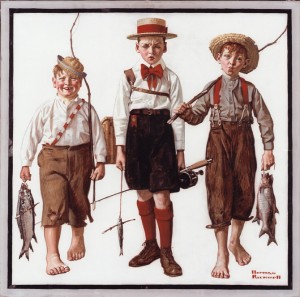
“The Catch,” Norman Rockwell, 1919. Oil on canvas, 29″ x 29″. Cover illustration for “Country Gentleman,” May 3, 1919. Gift of the Rodger P. Nordblom Family. From the permanent collection of Norman Rockwell Museum.
Press images available upon request
Norman Rockwell Museum announces the recent acquisition of several important original works of art by noted American illustrators, including its namesake Norman Rockwell, Charles Dana Gibson, James Montgomery Flagg, Victor C. Anderson, Winfield Scott Lukens, Tom Lovell, Thomas Fogarty, Fletcher Martin, and Saul Tepper. The donations will enhance the Museum’s growing collection of illustration art.
As the custodians of the world’s largest collection of original artwork by Norman Rockwell (1894-1978), the Museum continues to collect works by the beloved illustrator. Through the generosity of the Rodger P. Nordblom family, the Museum has acquired two 1919 paintings the artist created for “The Country Gentleman”: “Fishing Trip, They’ll Be Coming Back Next Week” and “The Catch.” The paintings were part of a series of cover illustrations Rockwell created for the magazine between 1917 and 1920, following the antics of four fictional young boys: Master Reginald Claude Fitzhugh, Tubby Doolittle, Rusty Doolittle, and Chuck Peterskin. The illustrations were published consecutively, in order to complete a narrative about the boys’ varying degrees of success during a fishing trip.
Another theme which Rockwell revisited several times during his career, was the story of children disobeying a “No Swimming” sign. For the June 15, 1929 cover of “The Saturday Evening Post,” the artist created an illustration which featured a bashful young girl averting her eyes from the disorderly display, while passing by the familiar hand-painted sign. The striking oil on canvas painting for the cover has been generously donated to the Museum by Jeanie Kull Low and John T.C. Low; the original model for the little girl, Ms. Low had always wished that the painting eventually be donated to Norman Rockwell Museum in her memory.
Representing work created by other artists, two of the Museum’s most recent acquisitions come courtesy of acclaimed portrait artist Everett Raymond Kinstler, who began his career as an illustrator. With artwork featured in the Museum’s permanent collection, Mr. Kinstler is perhaps best-known for his singular portrayals of such celebrated figures as John Wayne, Katharine Hepburn, and President Ronald Reagan; his most recent donations to Norman Rockwell Museum are important works by two significant Golden Age Illustrators: Charles Dana Gibson and James Montgomery Flagg. Gibson (1867-1944) created indelible images from the 1890s through 1910, which defined the age; remembered for his creation of the iconic Gibson Girl, the artist also produced illustrations for many popular books and magazines of the day. The Museum’s latest acquisition of original Gibson art, is one of 56 illustrations the artist created for author Robert W. Chambers’ 1911 novel “The Common Law;” the finished work was originally a gift from Gibson to fellow illustrator James Montgomery Flagg (1877-1960).
Flagg enjoyed his own considerable success and fame as an artist; at his peak, he was reported to have been the highest paid magazine illustrator, and is perhaps best-known for creating the 1917 World War I recruitment poster featuring Uncle Sam alongside the caption “I Want YOU for U.S. Army.”
As an aspiring illustrator, Everett Raymond Kinstler contacted Flagg during his youth, hoping to learn all that he could from a true master. A masterful artist himself today, he has generously donated to the Museum two rare oil paintings created by Flagg, ensuring the preservation and ongoing access to the accomplishments of his artistic mentor.
Other recent illustration art acquisitions include “Nurse with a Wounded Soldier,” a poignant 1943 study by Fletcher Martin (1904-1979), an artist war correspondent for “Life,” which published the final illustration on the magazine’s cover; this important donation is one of a series from Norman Rockwell Museum Trustee Steven Hirsch, which will enhance the Museum’s holdings from the World War II period. Recalling a different era, the Museum has also received a late 1890s frontier-themed painting by Winfield Scott Lukens (active 1896-1905), donated by contemporary illustrator and Norman Rockwell Museum Trustee Wendell Minor; and “The Man Without a God,” an early 1920s illustration by Victor C. Anderson (1882-1937). The Anderson work, whose theme recalls Norman Rockwell’s iconic 1942 painting “Freedom of Speech,” was donated by Norman Rockwell Museum National Council Member Robert T. Horvath, an accomplished artist and library director from Saint Michaels, Maryland. Inspired by his early interest in comics, Mr. Horvath has had a passion for illustration throughout his life, and over the years has donated many significant artworks to the Museum’s collection, including a fine pen and ink drawing by Norman Rockwell’s teacher Thomas Fogarty, and oil paintings by Rockwell’s studio mate, illustrator Edmund Ward. Collected through the years, Mr. Horvath’s outstanding collection of illustration art is generously intended for Norman Rockwell Museum.
Through the decades, the art of illustration has looked deeply into society, reflecting and shaping a rapidly changing world. Gifts of art to Norman Rockwell Museum makes continued scholarship possible for researchers today and into the future. To learn more, or to make your own tax-deductible donation of original Norman Rockwell or illustration art, please contact Norman Rockwell Museum’s Curatorial Department at 413.298.4100, ext. 208

